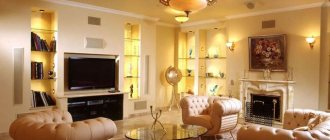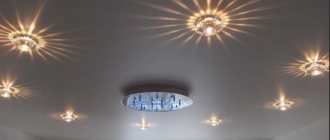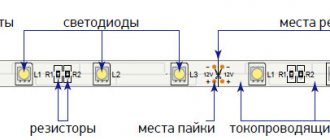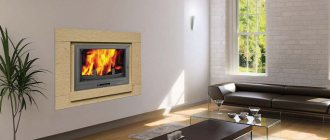Interior fashion is changing, of course, not at such a devastating speed as in clothing design, but it is nevertheless a very dynamic process. Therefore, you should not ignore modern trends in interior design, so that in a few years it looks fresh and relevant.
Lighting is divided into natural and artificial:
1. The first is street (daylight) light. It is impossible to stay indoors for a long time without it. Sunlight solves many problems.
- light is a natural antibiotic that disinfects the room. According to sanitary rules and building regulations, insolation (lighting by direct sunlight) of a living space should be at least 2 hours a day. All microdistricts and residential buildings in Russia are designed with this in mind.
- Natural lighting has a good effect on a person’s health and psychological state, increases immunity and reduces the risk of depression.
2. Second - all light sources inside the house. It is they and their proper placement that will help make the interior not only beautiful, but also comfortable for life (by this I mean the level of a person’s physical and psychological state). Let's talk about this.
Where to begin? Features of modern lighting in the interior
Start with yourself and determining your own needs!
Think about what you like to do, find a suitable area for it. Always try to answer the question “Why?”, then errors will be minimal.
For example: “There will be a sconce here because on this wall I want to hang my favorite reproduction and highlight it with light. And this simple sconce design will be white, like the wall, because the main thing is the picture and the emphasis should be on it.”
All lighting system details
In order for the lighting to work, switches are needed. This detail is usually not paid attention to. And in vain. They are just as susceptible to fashion as anything else. Let's remember a little about the different types of switches:
- keyboards,
- corded,
- push-button
- round with a brightness increasing wheel.
All these are old and familiar types that are still used today. They are being replaced by innovative switches:
- sensory,
- with remote control,
- with built-in sensor.
Previously, they tried to make them invisible, but today’s trend is to emphasize them. This can be done by playing with contrasts: on a white wall there is a black switch, on a black switch there are brass keys.
When creating your own unique interior, try to abandon stereotypes, look for fresh solutions, break traditions, now the emphasis on individuality is relevant.
Lighting scenarios in the apartment
You can create several scenarios in one space:
- bright main lighting (chandeliers and any ceiling lighting).
- muted evening, when bright light is not needed (sconces, floor lamps, decorative lamps, hidden lighting).
- accent lighting for an area or object. When you need to highlight something (ceiling and wall lamps with directional light).
- festive (decorative lamps, garlands)
When we talk about lighting options, we assume that different lamps will be turned on from different switches. You can also use pass-through switches for convenience. You can turn on the lighting from two switches located at different ends of the room. Such switches are convenient to use in long rooms, corridors, and bedrooms.
Using dimmers will also help in creating different lighting scenarios. The invention, of course, is not new, but very useful. Using a dimmer switch, you can adjust the illumination from each lamp. It is important to remember here that not all lamps are dimmable. Most LED lamps are non-dimmable.
Thinking through scenarios and making electrical wiring is one of the first stages in repairs.
An alternative to a chandelier - pendants
Pendant lamps resemble chandeliers, but, unlike them, they can emit not only diffused, but also directional light. With their help, space is perfectly zoned, and the ability to adjust the height of the suspension is very convenient. Everything that was said above about chandeliers applies here too. Spots can be used in pendant lamps, which means the beam of light can be directed in any direction. Choose lamps with geometric shapes or floral designs, avant-garde-futuristic, classic or retro, any of these, in accordance with your preferences - and you definitely can’t go wrong.
What to choose for the main lighting in the living room?
Chandelier
A chandelier is one of the types of pendant lamps designed to create shadow-free lighting.
The chandelier is the central element. It can become an accent in the interior, highlight a certain area, and act as the main source of lighting. For example, it will fit perfectly above the coffee table in the sofa area and become the main compositional element of the relaxation area. There is a truth and a minus: the possibility of rearranging furniture is limited by the fact that the chandelier organizes the space around itself.
In what interior is it appropriate to use a chandelier?
It is customary to emphasize the space with a chandelier, so it should be enough. Classic chandeliers are more vertically elongated, so they require high ceilings. Chandeliers in modern styles can be both horizontal and vertical.
If we talk about styles, designers are experimenting more and more and, along with understandable things, combining seemingly incompatible things! It is quite possible to find a classic chandelier in a concrete apartment, or, conversely, a modern geometric one - in walls with wide cornices and openwork moldings.
Using a classic chandelier in a traditional interior, you almost don’t have to worry about the result - it will probably fit well there! But if you want to make an unusual accent element, be careful! The rest of the interior in this case should become the background, here and there in small details only emphasizing the style of the chandelier.
The installation height depends largely on the situation. Usually at least 2.2 m from the floor, so as not to touch your head or hands. However, if the chandelier hangs above the coffee table in the living room, it would be appropriate to make it lower.
One chandelier in the center of the room will not solve the lighting issue. This is the main element that gives a lot of light, but with it alone the corners will remain in the shadows. Therefore, additional light sources are necessary.
Spot lighting (spots)
Spotlights are small lamps with directional light, having a certain angle of light propagation and radius of illumination.
Types of ceiling spotlights:
- built-in spots
- surface mounted lamps
- track systems
The peculiarity of the lamps is that they can be used both as main lighting and as accent lighting. The main thing is to choose the right lamp. Lamps come with different beam angles. For example, a conventional incandescent lamp has a scattering angle of 360 degrees, i.e. it shines in all directions and gives a general flood light. Halogen and LED spotlights with GU10 and GU5.3 sockets have a narrower angle. Most often it varies from 20 to 150 degrees. The range from 20 to 40 is suitable for local illumination of a painting or decorative elements. For basic lighting you need an angle of more than 60 degrees.
Spot and track lamps are appropriate in almost any interior, be it an interpretation of the classics, loft or minimalism. You can make them completely invisible or, conversely, accentuated.
If you use lamps as the main lighting, it is important to correctly calculate exactly how many lamps are needed and at what distance from each other they should be located. As a rule, the distance between spotlights is no more than 1.5 m. Of course, there are calculation formulas, but it is best to contact a lighting store, where the manager will help you determine the required power and number of lamps for your room.
Result:
Use a chandelier in a tall, large room in combination with additional lighting elements.
Spotlights are suitable for rooms with low ceilings, rooms with frequent rearrangements, and for accent lighting.
Decorative lighting
An inexpensive LED strip is most suitable for decorative lighting. The positive features of this product include ease of use, easy and quick installation. If the interior of the room is made in a classic style (with wooden furniture, pastel shades of the walls and tapestry), then the LEDs are replaced by local lamps and special luminous elements for decoration.
A distinctive feature of decorative lighting is the specificity of its use. It is used when it is necessary to hide lamps and make the light more subdued.
Neon lighting in the apartment
Such decorative lighting can be arranged using various LED and LED devices. Most often they are installed in suspended ceilings, in plasterboard niches. Flexible tubes or cords that glow with neon are often used.
Glass blocks in the interior of an apartment with lighting
Glass blocks are hollow cubes with glass walls about one centimeter thick. In Soviet times, such decorative elements were often used; they could be seen in the interior of bathhouses, hospitals, and staircases. Today, glass blocks have been improved - they are equipped with decorative lighting.
Floor lighting
Floor lighting is another solution with which you can give the room an unusual look. Various devices are used for lighting, these can be spotlights, LED strip, duralight cord, which are mounted in the plastic baseboard case or in glass floors.
Wall lamps (sconces) – which ones and why?
Wall lamps are sources of additional lighting mounted in a wall or on a wall. There are two types - built-in or overhead (sconces).
Overhead sconces come in different designs:
- Carobaceae. The most familiar and widespread type of sconce.
- Wall (surface). Appropriate in cases where the room is narrow so as not to interfere with the passage. Most often used in corridors and staircases.
- Lighting for pictures.
- Stationary. Sconces that do not have additional scenarios illuminate only in one position.
- Adjustable. The design of such sconces has movable elements, by controlling which you can change the lighting.
- With reflected light. Such sconces give a soft, light light. Most often, wall sconces are found with reflected light.
- With directional light.
The type of sconce largely depends on the style of the interior and its purpose.
Switch the main light to the sconce and achieve a subdued, cozy atmosphere. They will help organize a work area, a place for reading, and highlight an interesting wall texture.
If you want to use a sconce in your work area instead of a table lamp, try an option that can be adjusted from the wall up to 60 cm so that you can control the light as needed.
Remember, the lamp should not interfere with the passage. If the room is narrow, use surface sconces that do not protrude too much. Or ditch them altogether and use accent ceiling lighting.
Any lamp needs space, so choose a place for the sconce so that it is not “crowded” on the wall.
Kitchen and dining group
The kitchen area should have general lighting and work surface lighting. This is a set necessary for convenience and cooking.
In addition to uniform lighting with lamps, it would be nice to place a lamp above the dining group. This could be a pendant lamp or sconce.
The lamp should be installed in the kitchen at a height of 1.3-1.4 m from the floor (50-70 cm from the countertop).
If we talk about lamps above the bar counter, then the height here should be made a little higher - 1.6-1.8 m from the floor.
If the table is against the wall, you can use sconces. An interesting solution is a cantilever wall lamp with a reach of up to 1 meter in length. The installation height of such a lamp is also 50-70 cm from the tabletop.
If your room is small in size, do not overload it; use small lamps or lamps in light colors or with glass shades. Openwork lamps made of metal or wood can look impressive.
Many manufacturers produce series of lamps, in the same material, but in different sizes and shapes, and invite us to experiment and use our imagination. Combine in different combinations and hang at different heights!
Current floor lamps
Floor lamps add completeness to the interior and at the same time are mobile and independent. They may well become a spectacular art object if:
- will have an unusual futuristic design;
- bright contrasting color;
- distinctly fashionable character;
- sparkle with brass edges.
If you do not want the floor lamp to attract too much attention, then choose a lamp with laconic shapes and a discreet shade. And still the same commitment to natural materials and natural motifs.
What can you experiment with?
With wire!
Pendant lamps with textile braided wires look impressive. This can be a twisted wire or a simple round braided wire. The number of color options is huge!
Exposed wiring can be an interesting design element. Attach it to the surface of the wall or ceiling with clips for open wiring; if the cable is twisted, use insulators.
It is important to know!
If you use a ceiling lamp or chandelier in the center of the kitchen as the main lighting, do not hang pendant lamps above the dining room! They will "argue" with each other. The best solution would be sconces.
If the main lighting is spotlights, pendant lights above the dining room would be a great option!
Possible options for luminous flux distribution
Straight
– directional light illuminates a specific area, leaving the rest of the space in shadow. Organized using spot spots and track lamps.
Absent-minded
– glow from one or several sources softly and evenly fills the space. The light cones intersect, creating uniform and shadow-free illumination. Ceiling lamps with a special diffuser screen are used.
Reflected
– an original solution based on the effect of reflection of the light flux from the ceiling, walls, floor or a special screen. This is the most intimate and calming lighting option.
Corridor lighting
Let's consider several options. Let's say we have a wide, spacious hall with a width of at least 1.5 meters with a console table for keys or a banquette. For such a room, central lighting with a chandelier or overhead lamp is suitable. You can make sconces on the walls. Place them, for example, above a table or near a mirror. The installation height of sconces can vary from 1.6 to 1.8 m above floor level.
If your hallway is narrow and long, the best option would be to use recessed or surface-mounted accent lights.
Recessed lamps would be appropriate in a minimalist interior. These can be either spotlights or linear ones.
Advice! If you have a long corridor, you can visually make it smaller by making the far wall an accent wall and highlighting it. All bright or illuminated surfaces appear visually closer.
Bedroom lighting
The bedroom can also have main lighting in the form of a chandelier or spotlights. Although it is often not done in order to initially create a cozy atmosphere for relaxation and sleep. The issue of lighting in this case is solved with decorative lamps. This could be sconces, spot lighting of individual interior elements, or hidden LED lighting. And, of course, night lights by the bed so that, for example, you can read a book.
A convenient height for installing sconces for reading can be about 100-120 cm from the floor.
Bedside lamps can be pendant, wall, or table. By the way, they can be placed asymmetrically - on one side of the bed there is a lamp, on the other there is a table lamp.
If we talk about pendant lamps, you can combine 2-3 lamps together. The recommended installation height for the lampshade is 90 cm from the floor. In this case, it’s a good idea to think of a small hook for fixing them so that they don’t sway from side to side when you accidentally touch them or open a window and the wind blows.
The main thing for bedside lamps is that you can turn them on without getting out of bed. Choose lamps with a switch on the body. Or make a pass-through switch - one at the entrance to the bedroom, the second above the head of the bed.
Light in the nursery
A child’s room is a whole world with many tasks and functions - it is a bedroom, a playroom, and a workplace. There should be general lighting in the form of a chandelier or spotlights, a sconce by the bed (or pendant lamp), a table lamp, and possibly some other additional decorative lighting.
It is advisable to choose a sconce by the bed in the nursery with a power button on the body and a rotating one so that you can adjust the direction of the light. The installation height of the sconce is at least 50 cm above the bed.
Shower and toilet
In addition to general lighting, it is also good to have mirror lighting in the toilet. This could be a sconce or lighting mounted in a mirror. Its main purpose is to shine light on the face without creating cast shadows. Therefore, it is good if the sconce has a general flood light or with the ability to rotate the lampshade.
Interesting solutions can be obtained with LED backlights. It is only important to remember that it makes sense to highlight something beautiful. This could be a wall made of an unusual material (for example, stone, wood or relief) or a separate interesting element on the wall.
When choosing lamps for wet rooms, you must also look at the level of protection against moisture. It is designated IP44, where the first is protection against penetration of solid objects and dust on a scale of 0-6, the second is the degree of protection from moisture on a scale from 0 to 8. More about this in our other post about the protection class of devices - here . If the lamp is marked IP44, it is suitable for wet rooms.
Don't forget the bathroom
In the bathroom, light is often neglected, thinking that two light bulbs on the ceiling are enough. But even in this case, one must remember the rule of three types of lighting and take into account all human needs. To make the bathroom cozy, you will need lighting for the mirror and, possibly, the furniture. More light - more comfort!
Photo by ReRooms











